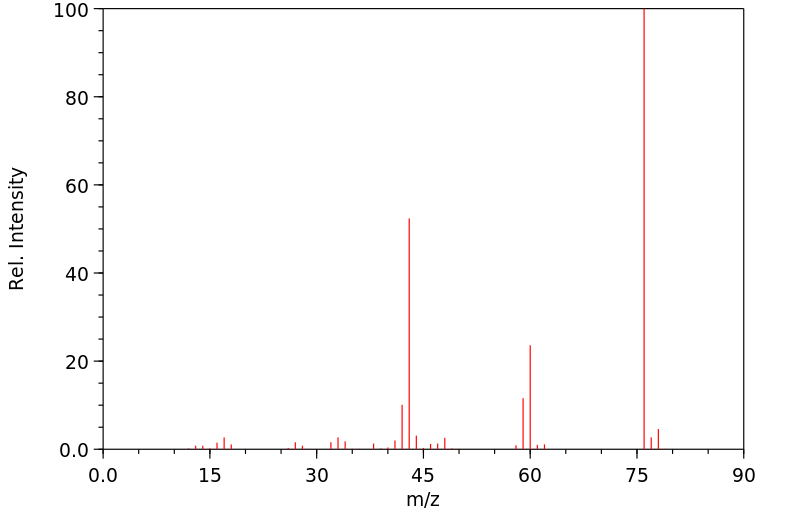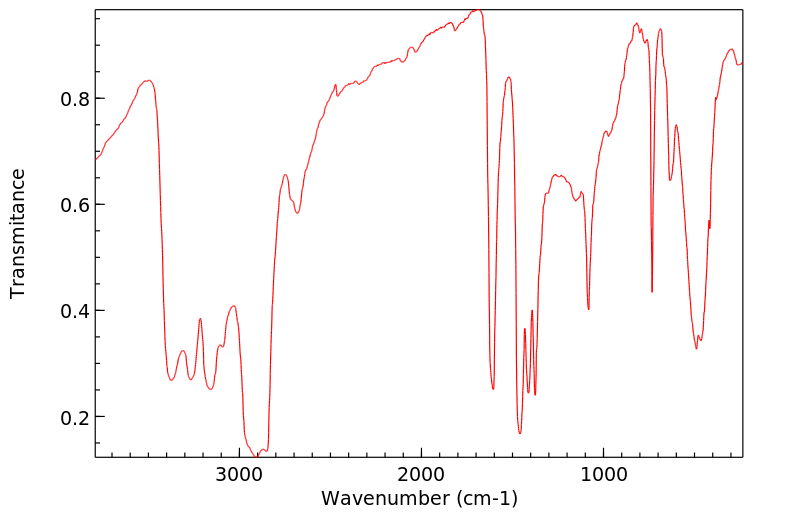硫脲 | 62-56-6
-
物化性质
-
计算性质
-
ADMET
-
安全信息
-
SDS
-
制备方法与用途
-
上下游信息
-
文献信息
-
表征谱图
-
同类化合物
-
相关功能分类
-
相关结构分类
物化性质
-
熔点:170-176 °C (lit.)
-
沸点:263.89°C (estimate)
-
密度:1.405
-
溶解度:水中的溶解度:137g/L,20°C
-
LogP:-1.050 (est)
-
物理描述:Thiourea appears as white or off-white crystals or powder. Sinks and mixes with water. (USCG, 1999)
-
颜色/状态:White solid which crystallizes in a rhombic bipyramidal structure
-
气味:Odorless
-
味道:Bitter
-
蒸汽压力:1.41X10-7 mm Hg at 25 °C
-
分解:When heated to decomposition it emits very toxic fumes of nitroxides and sulfoxides.
-
燃烧热:Heat of combustion at constant volume is -1482.2 kJ/mol (-19.47 kJ/g), and at constant pressure -1485.6 kJ/mol (-19.52 kJ/g)
-
汽化热:6.0034X10+7 J/kmol at 454.15 K (est)
-
表面张力:1.0404X10-2 N/m at 454.15 K
-
聚合:Acrylaldehyde is very reactive & will polymerize rapidly, accelerating to violence, in contact with strong acid or basic catalysts. ... Exposure to weakly acidic conditions (nitrous fumes, sulfur dioxide, carbon dioxide), some hydrolysable salts, or thiourea will also cause exothermic & violent polymerization.
-
解离常数:pK-value not determinable according to OECD guideline no. 112 with the titration method at 24 °C (forms no OH or H ions)
-
保留指数:531.5
-
稳定性/保质期:
-
在空气中易潮解。在150℃时会转变成硫氰酸铵。在真空下,于150-160℃升华,180℃时分解。具有还原性,能将游离态碘还原为碘离子。本品反应活性高,可用于制备多种化合物。它还能与多种氧化剂反应生成脲、硫酸及其他有机化合物,并能与无机化合物形成易溶解的加成化合物。
-
该物质一次性接触毒性较小,但反复接触可能经皮肤吸收,导致甲状腺和造血器官机能受抑制,引发中枢神经麻痹及呼吸和心脏功能下降等症状。长期生产此类物质的工人可能出现头痛、嗜睡、全身无力、皮肤干燥、口臭、口苦、腹痛、便秘、尿频等问题。典型症状包括面色苍白、面部虚肿、腹胀、基础代谢率降低、血压下降、脉搏减慢,心电图也会有变化。此外,还可能引发皮肤病等其他问题。该物质对蛙类的LD50为10mg/kg,对鼠类皮下注射的LD50为4g/kg。文献记载其对人体的致死量约为10g/kg。因此,在生产过程中,工人应佩戴防毒口罩,穿戴防护服,并注意安全。同时,生产设备需保持密闭状态,避免跑冒滴漏。
-
稳定性:稳定
-
禁配物:强氧化剂、强酸
-
避免接触的条件:受热
-
聚合危害:不聚合
-
分解产物:硫化物
-
计算性质
-
辛醇/水分配系数(LogP):-0.8
-
重原子数:4
-
可旋转键数:0
-
环数:0.0
-
sp3杂化的碳原子比例:0.0
-
拓扑面积:84.1
-
氢给体数:2
-
氢受体数:1
ADMET
安全信息
-
TSCA:Yes
-
危险等级:6.1
-
危险品标志:Xn
-
安全说明:S36/37,S61
-
危险类别码:R22,R51/53,R40,R63
-
WGK Germany:2
-
海关编码:2930909090
-
危险品运输编号:UN 2811 6.1/PG 3
-
危险类别:6.1
-
RTECS号:YU2800000
-
包装等级:III
-
危险标志:GHS07,GHS08,GHS09
-
危险性描述:H302,H351,H361d,H411
-
危险性防范说明:P201,P273,P301 + P312 + P330,P308 + P313,P391,P501
-
储存条件:储存注意事项: - 储存于阴凉、通风的库房。 - 远离火种、热源,包装密封。 - 应与氧化剂、酸类及食用化学品分开存放,切忌混储。 - 配备相应品种和数量的消防器材。 - 储区应备有合适的材料收容泄漏物。
SDS
模块 1. 化学品
1.1 产品标识符
: 硫脲
产品名称
1.2 鉴别的其他方法
Sulfourea
Thiocarbamide
1.3 有关的确定了的物质或混合物的用途和建议不适合的用途
仅用于研发。不作为药品、家庭或其它用途。
模块 2. 危险性概述
模块 16. 其他信息
进一步信息
上述信息视为正确,但不包含所有的信息,仅作为指引使用。本文件中的信息是基于我们目前所知,就正
确的安全提示来说适用于本品。该信息不代表对此产品性质的保证。
参见发票或包装条的反面。
2.1 GHS-分类
急性毒性, 经口 (类别 4)
急性毒性, 经皮 (类别 5)
皮肤刺激 (类别 2)
皮肤过敏 (类别 1)
致癌性 (类别 2)
生殖毒性 (类别 2)
急性水生毒性 (类别 2)
慢性水生毒性 (类别 2)
2.2 GHS 标记要素,包括预防性的陈述
象形图
警示词 警告
危险申明
H302 吞咽有害。
H313 接触皮肤可能有害。
H315 造成皮肤刺激。
H317 可能导致皮肤过敏反应。
H351 怀疑会致癌。
H361 怀疑对生育能力或胎儿造成伤害。
H411 对水生生物有毒并有长期持续的影响。
警告申明
预防措施
P201 在使用前获取特别指示。
P202 在读懂所有安全防范措施之前切勿操作。
P261 避免吸入粉尘/烟/气体/烟雾/蒸气/喷雾.
P264 操作后彻底清洁皮肤。
P270 使用本产品时不要进食、饮水或吸烟。
P272 禁止将污染的工作服带出作业场所。
P273 避免释放到环境中。
P280 戴防护手套。
事故响应
P301 + P312 如果吞咽并觉不适: 立即呼叫解毒中心或就医。
P302 + P352 如果皮肤接触:用大量肥皂和水清洗。
P308 + P313 如接触到或有疑虑:求医/ 就诊。
P321 具体处置(见本标签上提供的急救指导)。
P330 漱口。
P333 + P313 如出现皮肤刺激或皮疹:求医/就诊。
P362 脱掉沾污的衣服,清洗后方可再用。
P391 收集溢出物。
安全储存
P405 存放处须加锁。
废弃处置
P501 将内容物/ 容器处理到得到批准的废物处理厂。
2.3 其它危害物 - 无
模块 3. 成分/组成信息
3.1 物 质
: Sulfourea
别名
Thiocarbamide
: CH4N2S
分子式
: 76.12 g/mol
分子量
组分 浓度或浓度范围
Thiourea
<=100%
化学文摘登记号(CAS 62-56-6
No.) 200-543-5
EC-编号 612-082-00-0
索引编号
模块 4. 急救措施
4.1 必要的急救措施描述
一般的建议
请教医生。 向到现场的医生出示此安全技术说明书。
吸入
如果吸入,请将患者移到新鲜空气处。 如呼吸停止,进行人工呼吸。 请教医生。
皮肤接触
用肥皂和大量的水冲洗。 请教医生。
眼睛接触
用水冲洗眼睛作为预防措施。
食入
切勿给失去知觉者通过口喂任何东西。 用水漱口。 请教医生。
4.2 主要症状和影响,急性和迟发效应
据我们所知,此化学,物理和毒性性质尚未经完整的研究。
4.3 及时的医疗处理和所需的特殊处理的说明和指示
无数据资料
模块 5. 消防措施
5.1 灭火介质
灭火方法及灭火剂
用水雾,抗乙醇泡沫,干粉或二氧化碳灭火。
5.2 源于此物质或混合物的特别的危害
碳氧化物, 氮氧化物, 硫氧化物
5.3 给消防员的建议
如必要的话,戴自给式呼吸器去救火。
5.4 进一步信息
无数据资料
模块 6. 泄露应急处理
6.1 作业人员防护措施、防护装备和应急处置程序
使用个人防护用品。 避免粉尘生成。 避免吸入蒸气、烟雾或气体。 保证充分的通风。
人员疏散到安全区域。 避免吸入粉尘。
6.2 环境保护措施
如能确保安全,可采取措施防止进一步的泄漏或溢出。 不要让产品进入下水道。
一定要避免排放到周围环境中。
6.3 泄漏化学品的收容、清除方法及所使用的处置材料
收集和处置时不要产生粉尘。 扫掉和铲掉。 放入合适的封闭的容器中待处理。
6.4 参考其他部分
丢弃处理请参阅第13节。
模块 7. 操作处置与储存
7.1 安全操作的注意事项
避免接触皮肤和眼睛。 避免形成粉尘和气溶胶。
在有粉尘生成的地方,提供合适的排风设备。
7.2 安全储存的条件,包括任何不兼容性
贮存在阴凉处。 使容器保持密闭,储存在干燥通风处。
充气操作和储存
7.3 特定用途
无数据资料
模块 8. 接触控制和个体防护
8.1 容许浓度
最高容许浓度
没有已知的国家规定的暴露极限。
8.2 暴露控制
适当的技术控制
根据良好的工业卫生和安全规范进行操作。 休息前和工作结束时洗手。
个体防护设备
眼/面保护
面罩與安全眼鏡请使用经官方标准如NIOSH (美国) 或 EN 166(欧盟) 检测与批准的设备防护眼部。
皮肤保护
戴手套取 手套在使用前必须受检查。
请使用合适的方法脱除手套(不要接触手套外部表面),避免任何皮肤部位接触此产品.
使用后请将被污染过的手套根据相关法律法规和有效的实验室规章程序谨慎处理. 请清洗并吹干双手
所选择的保护手套必须符合EU的89/686/EEC规定和从它衍生出来的EN 376标准。
完全接触
物料: 丁腈橡胶
最小的层厚度 0.11 mm
溶剂渗透时间: 480 min
测试过的物质Dermatril® (KCL 740 / Z677272, 规格 M)
飞溅保护
物料: 丁腈橡胶
最小的层厚度 0.11 mm
溶剂渗透时间: 480 min
测试过的物质Dermatril® (KCL 740 / Z677272, 规格 M)
, 测试方法 EN374
如果以溶剂形式应用或与其它物质混合应用,或在不同于EN
374规定的条件下应用,请与EC批准的手套的供应商联系。
这个推荐只是建议性的,并且务必让熟悉我们客户计划使用的特定情况的工业卫生学专家评估确认才可.
这不应该解释为在提供对任何特定使用情况方法的批准.
身体保护
全套防化学试剂工作服, 防护设备的类型必须根据特定工作场所中的危险物的浓度和数量来选择。
呼吸系统防护
如危险性评测显示需要使用空气净化的防毒面具,请使用全面罩式多功能微粒防毒面具N100型(US
)或P3型(EN
143)防毒面具筒作为工程控制的候补。如果防毒面具是保护的唯一方式,则使用全面罩式送风防毒
面具。 呼吸器使用经过测试并通过政府标准如NIOSH(US)或CEN(EU)的呼吸器和零件。
模块 9. 理化特性
9.1 基本的理化特性的信息
a) 外观与性状
形状: 结晶
颜色: 白色
b) 气味
无臭
c) 气味阈值
无数据资料
d) pH值
5.0 - 7 在 50 g/l 在 20 °C
e) 熔点/凝固点
熔点/凝固点: 170 - 176 °C
f) 沸点、初沸点和沸程
无数据资料
g) 闪点
无数据资料
h) 蒸发速率
无数据资料
i) 易燃性(固体,气体)
无数据资料
j) 高的/低的燃烧性或爆炸性限度 无数据资料
k) 蒸气压
无数据资料
l) 蒸汽密度
无数据资料
m) 密度/相对密度
1.405 g/cm3 在 20 °C
n) 水溶性
137 g/l 在 20 °C
o) n-辛醇/水分配系数
辛醇--水的分配系数的对数值: -0.92 在 20 °C
p) 自燃温度
无数据资料
q) 分解温度
无数据资料
r) 粘度
无数据资料
模块 10. 稳定性和反应活性
10.1 反应性
无数据资料
10.2 稳定性
无数据资料
10.3 危险反应
无数据资料
10.4 应避免的条件
加热。
10.5 不相容的物质
强氧化剂, 强酸, 强碱
10.6 危险的分解产物
其它分解产物 - 无数据资料
模块 11. 毒理学资料
11.1 毒理学影响的信息
急性毒性
半数致死剂量 (LD50) 经口 - 大鼠 - 1,750 mg/kg
半数致死剂量 (LD50) 经皮 - 兔子 - > 2,800 mg/kg
皮肤刺激或腐蚀
无数据资料
眼睛刺激或腐蚀
无数据资料
呼吸道或皮肤过敏
无数据资料
生殖细胞致突变性
无数据资料
致癌性
该产品是或包含被IARC, ACGIH, EPA, 和 NTP 列为可能是致癌物的组分
在动物研究中的有限致癌性证据
IARC:
3 - 第3组:未被分类为对人类致癌 (Thiourea)
生殖毒性
可疑人类的生殖毒物
特异性靶器官系统毒性(一次接触)
无数据资料
特异性靶器官系统毒性(反复接触)
无数据资料
吸入危险
无数据资料
潜在的健康影响
吸入 吸入可能有害。 引起呼吸道刺激。
摄入 误吞对人体有害。
皮肤 通过皮肤吸收可能有害。 造成皮肤刺激。
接触后的征兆和症状
据我们所知,此化学,物理和毒性性质尚未经完整的研究。
附加说明
化学物质毒性作用登记: YU2800000
模块 12. 生态学资料
12.1 生态毒性
对鱼类的毒性 半数致死浓度(LC50) - 斑马担尼鱼(斑马鱼) - 10.000 mg/l - 96.0 h
对水蚤和其他水生无脊 半数效应浓度(EC50) - 大型蚤 (水蚤) - 5.6 - 18.0 mg/l - 48 h
椎动物的毒性
对藻类的毒性 半数效应浓度(EC50) - 近具刺链带藻 (绿藻) - 6.8 mg/l - 96 h
12.2 持久性和降解性
生物降解能力 生物的/需氧的 - 接触时间 31 d
结果: < 1 % - 不易生物降解。
12.3 潜在的生物累积性
无数据资料
12.4 土壤中的迁移性
无数据资料
12.5 PBT 和 vPvB的结果评价
无数据资料
12.6 其它不良影响
对水生生物有毒并有长期持续的影响。
模块 13. 废弃处置
13.1 废物处理方法
产品
将剩余的和不可回收的溶液交给有许可证的公司处理。
与易燃溶剂相溶或者相混合,在备有燃烧后处理和洗刷作用的化学焚化炉中燃烧
受污染的容器和包装
按未用产品处置。
模块 14. 运输信息
14.1 联合国危险货物编号
欧洲陆运危规: 3077 国际海运危规: 3077 国际空运危规: 3077
14.2 联合国运输名称
欧洲陆运危规: ENVIRONMENTALLY HAZARDOUS SUBSTANCE, SOLID, N.O.S. (Thiourea)
国际海运危规: ENVIRONMENTALLY HAZARDOUS SUBSTANCE, SOLID, N.O.S. (Thiourea)
国际空运危规: EnvironmeNTAhref=https://www.molaid.com/MS_112097 target="_blank">NTally hazardous subSTance, solid, n.o.s. (Thiourea)
14.3 运输危险类别
欧洲陆运危规: 9 国际海运危规: 9 国际空运危规: 9
14.4 包裹组
欧洲陆运危规: III 国际海运危规: III 国际空运危规: III
14.5 环境危险
欧洲陆运危规: 是 国际海运危规 国际空运危规: 是
海洋污染物(是/否): 是
14.6 对使用者的特别提醒
进一步信息
危险品独立包装,液体5升以上或固体5公斤以上,每个独立包装外和独立内包装合并后的外包装上都必须有EHS
标识 (根据欧洲 ADR 法规 2.2.9.1.10, IMDG 法规 2.10.3),
模块 15 - 法规信息
N/A
制备方法与用途
硫脲,英文名:Thiourea,是一种白色光亮的苦味晶体,能溶于冷水和乙醇,微溶于乙醚。它在空气中容易潮解,在150℃时会转变为硫氰酸铵,并且具有还原性,可以将游离态碘还原成碘离子。此外,硫脲反应性强,可用于制备多种化合物。
用途硫脲广泛应用于石油化工、医药化工等领域。许多药物分子中都含有硫脲结构片段,如口服降糖药和抗甲状腺药物等。此外,它在杀虫剂方面也有广泛应用,并且是合成杂环化合物的重要中间体。硫脲还能用于制造甲基硫脲、二乙基硫脲等多种衍生物。
化学性质硫脲为白色或浅黄色有光泽的片状、柱状或针状结晶,具有苦味。它能够溶于水和乙醇,几乎不溶于乙醚。
用途 特殊用途 其他应用领域 生产方法硫脲可以通过多种方法制备。一种常见的生产方式是将石灰乳在负压和冷却条件下吸收硫化氢,生成硫氢化钙溶液。随后,该溶液与氰氨化钙按1:5摩尔比反应3小时,过滤、浓缩后冷却结晶即可获得成品。此外,也可以使用硫氰酸铵法或重氮甲烷法制备。
反应方程式- BaS + H₂SO₄ → BaSO₄↓ + H₂S↑
- 2H₂S + Ca(OH)₂ → Ca(SH)₂ + 2H₂O
- 2CaCN₂ + Ca(SH)₂ + 6H₂O → 2(NH₂)₂CS + 3Ca(OH)₂
硫脲属有毒物品,毒性分级为高毒。口服对大鼠的LD₅₀值为125毫克/公斤,腹腔对小鼠的LD₅₀值为100毫克/公斤。
上下游信息
反应信息
-
作为反应物:参考文献:名称:Thiourea dioxide with TBHP: a fruitful and greener recipe for the catalytic oxidation of alcohols摘要:二氧化硫脲因其氢键能力,已被确立为一种卓越、应用广泛的 organocatalyst。在本文中,作为 organocatalyst 的二氧化硫脲与无毒且环境友好的氧化剂 t-丁基过氧化氢(TBHP)结合,成为在温和反应条件下将醇高效氧化为相应羰基化合物的绿色且富有成果的方法。DOI:10.1039/c3ra21971b
-
作为产物:参考文献:名称:一种硫脲的合成方法摘要:本发明属于有机合成技术领域,具体涉及一种硫脲的合成方法。以羰基硫、与氨气为原料通入溶剂中,合成目标产物硫脲,也可加入适量催化剂促进反应进行,催化剂是氯化钙、分子筛中的一种。该发明操作步骤简单,能耗低,生产周期短,产品收率和纯度高,满足市场对硫脲的质量要求;原料易得且价格较低;反应无固废产生,具有很高的环保价值,适合工业化生产。公开号:CN110343060A
-
作为试剂:参考文献:名称:具有不同骨架的一系列诺卡酮类似物的合成摘要:利用羰基合成了一系列 Nootkatone 环扭曲类似物,包括 6 种 CTD(复杂多样性)化合物和 9 种 SAR(结构活性关系)化合物。DOI:10.1080/10286020.2024.2358834
文献信息
-
[EN] CRBN LIGANDS AND USES THEREOF<br/>[FR] LIGANDS CRBN ET LEURS UTILISATIONS申请人:KYMERA THERAPEUTICS INC公开号:WO2019140387A1公开(公告)日:2019-07-18The present invention provides compounds, compositions thereof, and methods of using the same for the inhibition of CRBN, and the treatment of CRBN-mediated disorders.本发明提供了化合物、其组合物以及使用这些化合物抑制CRBN并治疗CRBN介导的疾病的方法。
-
[EN] SULFONYL COMPOUNDS THAT INTERACT WITH GLUCOKINASE REGULATORY PROTEIN<br/>[FR] COMPOSÉS DE SULFONYLE QUI INTERAGISSENT AVEC LA PROTÉINE RÉGULATRICE DE LA GLUCOKINASE申请人:AMGEN INC公开号:WO2013123444A1公开(公告)日:2013-08-22The present invention relates to sulfonyl compounds that interact with glucokinase regulatory protein. In addition, the present invention relates to methods of treating type 2 diabetes, and other diseases and/or conditions where glucokinase regulatory protein is involved using the compounds, or pharmaceutically acceptable salts thereof, and pharmaceutical compositions that contain the compounds, or pharmaceutically acceptable salts thereof.
-
Photoredox chemistry in the synthesis of 2-aminoazoles implicated in prebiotic nucleic acid synthesis作者:Ziwei Liu、Long-Fei Wu、Andrew D. Bond、John D. SutherlandDOI:10.1039/d0cc05752e日期:——Prebiotically plausible ferrocyanide–ferricyanide photoredox cycling oxidatively converts thiourea to cyanamide, whilst HCN is reductively homologated to intermediates which either react directly with the cyanamide giving 2-aminoazoles, or have the potential to do so upon loss of HCN from the system. Thiourea itself is produced by heating ammonium thiocyanate, a product of the reaction of HCN and hydrogen
-
NOVEL GLUCOKINASE ACTIVATORS AND METHODS OF USING SAME申请人:Ryono Denis E.公开号:US20080009465A1公开(公告)日:2008-01-10Compounds are provided which are phosphonate and phosphinate activators and thus are useful in treating diabetes and related diseases and have the structure wherein is a heteroaryl ring; R 4 is —(CH 2 ) n -Z-(CH 2 ) m —PO(OR 7 )(OR 8 ), —(CH 2 ) n Z-(CH 2 ) m —PO(OR 7 )R g , —(CH 2 ) n -Z-(CH 2 ) m —OPO(OR 7 )R g , —(CH 2 ) n Z—(CH 2 ) m —OPO(R 9 )(R 10 ), or —(CH 2 ) n Z—(CH 2 ) m —PO(R 9 )(R 10 ); R 5 and R 6 are independently selected from H, alkyl and halogen; Y is R 7 (CH 2 ) s or is absent; and X, n, Z, m, R 4 , R 5 , R 6 , R 7 , and s are as defined herein; or a pharmaceutically acceptable salt thereof. A method for treating diabetes and related diseases employing the above compounds is also provided.提供了磷酸酯和磷酸酯激活剂,因此在治疗糖尿病和相关疾病方面非常有用,并具有以下结构: 其中 是杂环芳基环; R 4 为—(CH 2 ) n -Z-(CH 2 ) m —PO(OR 7 )(OR 8 )、—(CH 2 ) n Z-(CH 2 ) m —PO(OR 7 )R g 、—(CH 2 ) n -Z-(CH 2 ) m —OPO(OR 7 )R g 、—(CH 2 ) n Z—(CH 2 ) m —OPO(R 9 )(R 10) 或—(CH 2 ) n Z—(CH 2 ) m —PO(R 9 )(R 10) ; R 5 和R 6 分别选择自H、烷基和卤素; Y为R 7 (CH 2 ) s 或不存在;以及 X、n、Z、m、R 4 、R 5 、R 6 、R 7 和s如本文所定义;或其药用盐。 还提供了一种利用上述化合物治疗糖尿病和相关疾病的方法。
-
Combination of FBPase inhibitors and insulin sensitizers for the treatment of diabetes申请人:Metabasis Therapeutics, Inc.公开号:US06756360B1公开(公告)日:2004-06-29Pharmaceutical compositions containing an FBPase inhibitor and an insulin sensitizer are provided as well as methods for treating diabetes and diseases responding to increased glycemic control, an improvement in insulin sensitivity, a reduction in insulin levels, or an enhancement of insulin secretion.
表征谱图
-
氢谱1HNMR
-
质谱MS
-
碳谱13CNMR
-
红外IR
-
拉曼Raman
-
峰位数据
-
峰位匹配
-
表征信息








